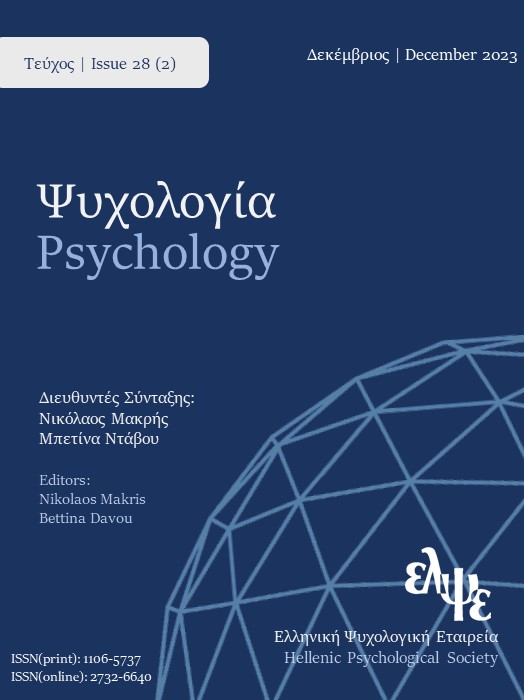Δομή και ψυχομετρικά χαρακτηριστικά της Ανιχνευτικής Κλίμακας Γλωσσικής Ανάπτυξης

Περίληψη
Η ανίχνευση της αναπτυξιακής γλωσσικής διαταραχής αποτελεί αναγνωρισμένη αναγκαιότητα, καθώς είναι το πρώτο βήμα για τον εντοπισμό πιθανής γλωσσικής υπολειτουργικότητας, με απώτερο στόχο το σχεδιασμό και την εφαρμογή μιας πρώιμης παρέμβασης. Στην ελληνική γλώσσα έχουν κατασκευαστεί και σταθμιστεί ελάχιστες ανιχνευτικές κλίμακες γλωσσικών δυσκολιών για την προσχολική ηλικία. Η Ανιχνευτική Κλίμακα Γλωσσικής Ανάπτυξης (ΑΚΓΑ) σχεδιάστηκε λαμβάνοντας υπόψη την πρόσφατη βιβλιογραφία και έρευνα που σχετίζεται με κλινικούς δείκτες και προγνωστικούς παράγοντες της αναπτυξιακής γλωσσικής διαταραχής κατά την προσχολική ηλικία. Στην παρούσα μελέτη εξετάστηκε η αξιοπιστία και η δομική εγκυρότητα της κλίμακας με τη χρήση επιβεβαιωτικών δομικών μοντέλων σε δείγμα 476 παιδιών ηλικίας 3:6-4:6 ετών (Νκοριτσιών=258) το οποίο λήφθηκε με αναλογική στρωματοποιημένη τυχαία δειγματοληψία. Η ανάλυση έδειξε ότι το αμφιπαραγοντικό μοντέλο εξηγεί ικανοποιητικά τα δεδομένα. Μελετήθηκε ακόμη η εσωτερική συνοχή των στοιχείων της κλίμακας με τη χρήση του δείκτη ωμέγα (omega). Για να τεκμηριωθεί η συγχρονική, η συγκλίνουσα και η αποκλίνουσα εγκυρότητα της ΑΚΓΑ χορηγήθηκαν έξι επιπλέον ψυχομετρικά εργαλεία σε ένα επιπρόσθετο δείγμα 44 παιδιών. Τα αποτελέσματα έδειξαν ότι η ΑΚΓΑ αποτελεί ένα έγκυρο και αξιόπιστο ανιχνευτικό εργαλείο για τον εντοπισμό των παιδιών προσχολικής ηλικίας που βρίσκονται σε κίνδυνο να εμφανίσουν αναπτυξιακή γλωσσική διαταραχή.
Λεπτομέρειες άρθρου
- Πώς να δημιουργήσετε Αναφορές
-
Σπανούδης Γ., & Κανικλή Ά. (2023). Δομή και ψυχομετρικά χαρακτηριστικά της Ανιχνευτικής Κλίμακας Γλωσσικής Ανάπτυξης. Ψυχολογία: το περιοδικό της Ελληνικής Ψυχολογικής Εταιρείας, 28(2), 251–273. https://doi.org/10.12681/psy_hps.26212
- Ενότητα
- ΕΜΠΕΙΡΙΚΕΣ ΕΡΓΑΣΙΕΣ

Αυτή η εργασία είναι αδειοδοτημένη υπό το Creative Commons Attribution-ShareAlike 4.0 International License.
Το περιοδικό ΨΥΧΟΛΟΓΙΑ έχει υιοθετήσει μία πολιτική Platinum open-access. Τα έξοδα υποβολής, επεξεργασίας ή δημοσίευσης των εργασιών καλύπτονται από την Ελληνική Ψυχολογική Εταιρεία. Τα πνευματικά δικαιώματα των δημοσιευμένων εργασιών προστατεύονται από την άδεια 'Creative Commons Attribution-ShareAlike 4.0 International'. Οι Συγγραφείς διατηρούν τα Πνευματικά Δικαιώματα και χορηγούν στο περιοδικό το δικαίωμα της πρώτης δημοσίευσης. Η άδεια αυτή επιτρέπει σε τρίτους, να χρησιμοποιούν την εργασία σε οποιαδήποτε μορφή, με την προϋπόθεση της διατήρησης των διατυπώσεων που προβλέπονται στην άδεια σχετικά με την αναφορά στον αρχικό δημιουργό και την αρχική δημοσίευση στο περιοδικό ΨΥΧΟΛΟΓΙΑ. Επιπλέον, κάθε διανομή της εργασίας οφείλει να γίνεται με τους ίδιους όρους διανομής, δηλαδή με την ίδια άδεια Creative Commons.


